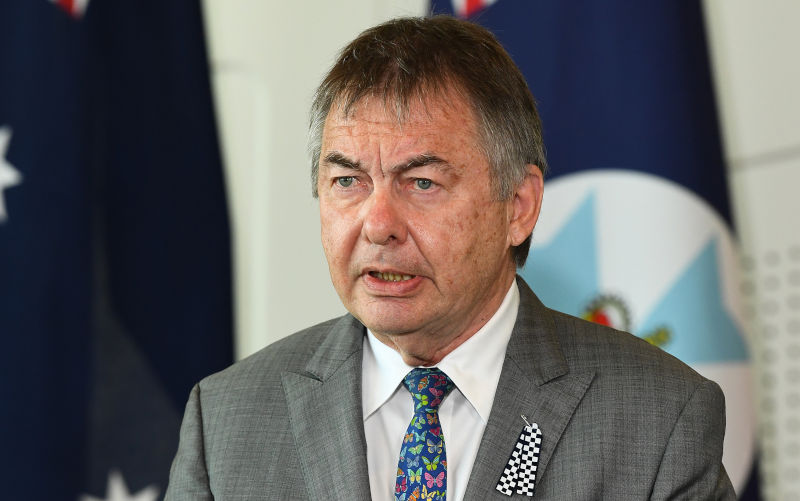Will Walter Sofronoff be prosecuted?
March 22, 2025
Maybe what Lehrmann Board of Inquiry chair Walter Sofronoff KC did was “serious corrupt conduct”, as the ACT Integrity Commission alleges. Or perhaps that description is “overreach”, as former Law Council of Australia president Arthur Moses SC told The Australian.
But handing your report to journalists before handing it to the chief minister who commissioned you to write it is just plain dumb.
Like the drunken young buck who jobs another late-night lumbering punter under one of Civic’s manifold CCTV cameras, Sofronoff was always going to get caught.
His was a small board of inquiry in a small town. There’s only one truck the report could have fallen from.
Full marks to Janet Albrechtsen of The Australian and Elizabeth Byrne of the ABC. Great scoop.
Sofronoff was appointed to head an inquiry into how police and prosecutors conducted themselves in the case in which Bruce Lehrmann was accused of rape in a trial aborted for juror misconduct. He was not retried.
The inquiry made damning findings against then Director of Public Prosecutions Shane Drumgold, SC, who personally ran the case, and who would resign. He has since become a frequent social-media commentator, giving his extensive professional qualifications, but also describing himself as a “has-been boxer”.
Drumgold, very much up for the fight with Sofronoff, initiated an action in the Supreme Court against the Board of Inquiry.
Acting Justice Stephen Kaye found in that case that Sofronoff’s findings had been infected by an apprehension of bias (while upholding the majority of his findings against Drumgold).
Enter the ACT Integrity Commission with its findings against Sofronoff, who, within hours, had launched a Federal Court challenge to the lawfulness of the commission report.
By his plentiful contact with journalists (65 calls, 55 of them to The Australian) and his delivery to journalists of the report before it was officially released, the commission found Sofronoff had “threatened public confidence” in his inquiry’s processes and in the judgments in its final report. Was he overstretching in what might be seen as a very public fight with Drumgold?
Most seriously, the commission found “that the conduct of Mr Sofronoff in making the impugned communications could constitute a criminal offence".
Getting a scoop is great. That’s a journo’s job and The Australian certainly made a splash with what it had.
But most journos now are also commentators, looking to influence public affairs, an aspect the Integrity Commission report did not miss.
Sofronoff’s regular contact with Albrechtsen throughout the inquiry meant he had “lost sight of the important public function he was discharging”.
“Parallel to the known board processes, Mr Sofronoff was engaging privately with Ms Albrechtsen, a journalist, who was not a participant in the inquiry and who was known to have strong views about issues that would certainly be the subject of the report to government,” the report said, going on to note Acting Justice Kaye’s description of Sofronoff as a “fellow traveller” with Albrechtsen.
Again, in my view, no criticism should fall on Albrechtsen over that. Journos, at least in my almost three decades in the caper, were supposed to be stirrers, even ratbags.
It’s different for a Court of Appeal judge, one of His Majesty’s learned silks. The judge’s actions in my view were plain dumb. But criminal?
The commission report goes to some pains to point out the difference between the civil standard of proof (the balance of probabilities) and the criminal standard (beyond reasonable doubt). It states flatly, and absolutely correctly, “An investigation under the Integrity Commission Act is not a trial.”
Sofronoff’s conduct fell within several elements of the definition of “corrupt conduct” in the Integrity Commission Act with his disclosure of confidential material to journalists perhaps contrary to his obligations in the Inquiries Act.
Section 17 of the Inquiries Act provides that “a person who is or has been a member … of a board … must not, either directly or indirectly, except in the exercise of a function under this Act … produce to any person, or permit any person to have access to, a document provided for this Act”.
The maximum penalty is a fine of up to $8000 and/or imprisonment for six months.
Section 36 specifies that “a person commits an offence if the person does something in the face, or within the hearing, of a board that would be contempt of court if the board were a court of record”.
Maximum penalty? Fine of up to $16,000 and/or imprisonment for one year.
To finish back with that drunken wannabe pugilist on the CCTV. He’d be likely facing an assault charge (two years’ prison; or five if it caused actual bodily harm) or perhaps affray (between two and 10 years, depending how many were engaging in the conduct).
Quite often, we criminal defenders make representations to have the DPP replace such allegations with a wonderful old charge which carries only a fine, no imprisonment at all.
It’s Section 391 of the Crimes Act: “A person shall not fight with another person in a public place.”
Of course, it’s flippant to suggest such a charge for Sofronoff, but when you consider various of the Prosecution guidelines in the territory, such as “the antecedents and background of the accused”; “the likely length and expense of a trial”; “the likely outcome in the event of a finding of guilt” (where a non-conviction order would have to loom large, in my view), s391 starts to look like about the right level of criminal responsibility.
But, against that, are other, very important guidelines, including “the effect on public order and morale”; “whether the alleged offence is of considerable public concern” and, most importantly, “the need to maintain public confidence in such basic institutions as parliament and the courts”.
Yet more serious decisions remain to be made in this case that never ends.

